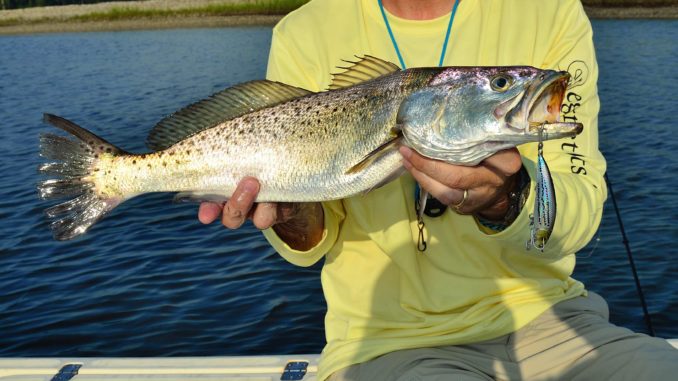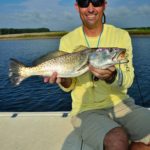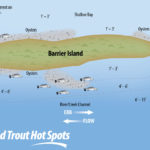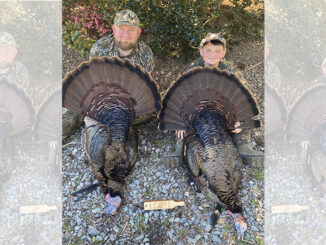
Georgetown’s waters offer speckled trout some of the best habitat in South Carolina, and October is time to probe it.
After a long, hot summer, fall has arrived on the calendar, and it true fall conditions should arrive this month. For the inshore angler with a passion for casting lures at grass lines and oyster points, the fun-filled October session is the just what the doctor ordered, because a squadron of speckled trout show up looking to stretch their stomachs on shrimp, mullet and menhaden. Anglers visiting the Georgetown, South Carolina’s third-oldest city, will be more than pleased.
If you could create an area loaded with a perfect mix of freshwater, saltwater, oyster beds and grass, the flooded terrain east of Georgetown’s city limits would be it. From the salty marshes behind Debordieu Colony to the expansive Santee Delta — and all of the prized waters in between — this habitat is flawless, making for an angler’s paradise, with specks at the top of the hit list.
By October, the bays and waterways are chock full of fat shrimp and tons of baitfish. As the water temperature continues to decline, the parade of shrimp and bait march down grassy shorelines, oyster bars and creek mouths that double as perfect feeding zones for the flood of speckled trout here to pack on the pounds. If there was ever a time to come to Georgetown to go after a speckled trout, this would be it.
Guide Jordan Pate of Carolina Guide Service spends almost every day this month on the water chasing speckled trout.
“October is the beginning of the best trout fishing of the year,” said Pate. “There is so much bait around, the fish just go crazy.”
The cooling water combined with the abundance of bait will easily cause a feeding frenzy, and it makes lots of places good locations to go after a speckled trout.
Pate will fish anywhere from the creeks off North Inlet all the way to the Cape Romain National Seashore. This month, the flood of fish that migrate into the area makes just about any fishy looking place productive. But Pate will concentrate on islands and shorelines abundant with oysters and close to deep water.
“The shell banks in Winyah Bay are one of the best places to find trout in the fall. The bay fills up with shrimp and bait that makes these shell islands a perfect ambush position,” he said.
These shell banks are spoil islands along the shipping channel, loaded with rocky substrate. Due to their proximity, they receive constant flow from the incoming and outgoing tide that is a perfect concoction for speckled trout, but Pate will also fish the shorelines along the bay and in the main creeks swarming with live bait.
“Anywhere you can find large accumulations of bait passing along pinch points, the trout will be there feeding,” Pate said.
Trout are ambush feeders. They look for moving water close to structure, preferable clean and clear water. They rely on their sight to make a living, and the clear water gives them the upper hand on incoming meals.
Georgetown anglers can expect to catch a wide assortment of trout of all sizes, but guide Jeff Lattig of Living Water Guide Service looks to catch his biggest trout of the year during October and November.
“The water starts cooling down, and they get super aggressive,” said Lattig. “I start throwing big plugs to catch big trout. I like to use plugs that push a lot of water.”
The annual mullet run takes place in October; massive schools of baitfish are moving in and out of the estuaries, and many of the local mullet have grown up to adult sizes and are targets for the big specks.
“Big trout are meat eaters, and they will be looking to eat something with a large profile,” Lattig said.
While some of the bigger trout will slide along the shallow shorelines to feed, Lattig concentrates mostly on places close to deep water.
“The big trout will lay in deep channels next to a current rip and wait for the bait to wash by,” said Lattig, whose favorite lures for jumbo specks are Zara Spooks, X-Raps or 5-inch D.O.A. CAL jerkbaits.
“The bigger the better is what I go by. You may not get a lot of bites, but it is the only way to catch a trophy trout,” he said.
Pate looks for trophy trout around the Winyah Bay jetties in the fall.
“The jetties have everything: clean water, depth, structure, current and plenty of bait. I will fish many places during the fall, but we always stop by the jetties during some portion of the trip because trout are always stacked up there in the fall, and a lot of times we catch a few lunkers,” he said.
Since trout are feeding on shrimp and many different kinds of baitfish, live shrimp and minnows under a popping cork will always be good when floated over these structures and across pinch points. Trout will be lying adjacent to the structure or along the shell bottom waiting for bait to sweep past.
For anglers with an artificial frame of mind, fall is a perfect opportunity to use lures — just about anything that resembles a shrimp or live minnow. Pate’s boat will be stocked with a full complement of 3 ½-inch soft plastics, 1/8- and ¼-ounce jig heads, 3 ½-inch Vudu Shrimp and a handful of Spook Junior topwater lures in a variety of bright and natural colors.
“We catch them on about everything in the fall. I will keep several rods rigged with different options and will always have a topwater plug ready early in the day,” he said.
While Lattig will provide spinning gear and an entire assortment of lures to his parties, much of his clientele comes prepared to fly fish. He’ll use just about any type of small fly this time of year, including small, weighted Clouser minnows and shrimp imitations in white, chartreuse, pink and green. Early and late in the day, he will use gurglers, Bob’s Banger poppers and other poppers regularly.
“Trout are sight-feeders, and the bright colors usually work better this time of year, but I will still use blacks and browns in the stained waters of the bay,” he said.
DESTINATION INFORMATION
WHERE TO GO — The speckled trout bite from North Inlet all the way to the Santee Delta, with the water temperature and location of bait determining which areas are best at any particular time. The Winyah Bay jetties, the shell banks in the bay, main creeks following to North Inlet and the Santee Delta will all hold trout. Concentrate on grass edges and oyster banks/points with steady current flow. Don’t leave any creek mouth with oysters unfished. Trout will stage all along the ICW south of the South Island Ferry. Any kind of irregularity along the channel such as docks and other man-made structures will congregate bait and fall speckled trout.
HOW TO GET THERE — Georgetown is north of Charleston and south of the Grand Strand on US 17. Prime waters include North Inlet, Winyah Bay and the Santee Delta, which are accessible from three main public boat ramps: South Island Ferry on South Island Ferry Road, the East Bay Park landing at the ballpark in downtown Georgetown, and the Carroll Campbell marine complex off US 17 at the base of the Sampit River bridge.
WHEN TO GO — October through December mark good fishing for speckled trout around Georgetown, with November the peak month. The fishing should be great anytime the water temperature is between 59 and 64 degrees.
BEST TECHNIQUES — Live bait is tough to beat, either mullet minnows or shrimp fished under a float, but fall is a great time for artificial baits, from topwater plugs to sinking and diving baits, as well as soft-plastic shrimp and minnow imitations. They can be fished on light jigheads. Use 6-foot-6 to 7-foot medium too medium-light spinning outfits and reels spooled with 14- to 20-pound braid and 24-inch of 20-pound fluorocarbon leader.
FISHING INFO/GUIDES — Jordan Pate, Carolina Guide Service, 843-608-8307, www.carolinaguideservice.com; Jeff Lattig, Living Water Guide Service, 843-997-4655, www.livingwaterguide.com. See also Guides and Charters in Classifieds.
ACCOMMODATIONS —Hampton Inn-Georgetown Marina, 843-545-5000; Georgetown Area Visitors Center, www.visitgeorgetown.com; Myrtle Beach Area Convention and Visitors Bureau, www.mbchamber.com; South Carolina Association of Visitors Bureaus, www.discoversouthcarolina.com.
MAPS — Navionics, 800-848-5896, www.navionics.com; The Good Spots, 800-411-0185, www.thegoodsports.com; DeLorme’s South Carolina Atlas & Gazetteer, 207-847-7000, www.delorme.com.







Be the first to comment